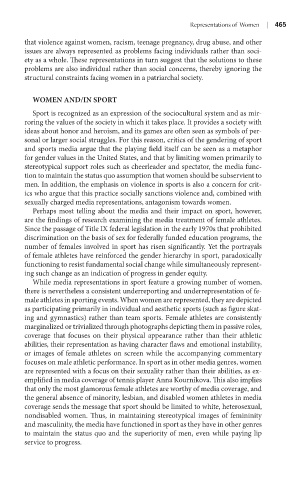Page 486 - Battleground The Media Volume 1 and 2
P. 486
Representat ons of Women |
that violence against women, racism, teenage pregnancy, drug abuse, and other
issues are always represented as problems facing individuals rather than soci-
ety as a whole. These representations in turn suggest that the solutions to these
problems are also individual rather than social concerns, thereby ignoring the
structural constraints facing women in a patriarchal society.
womEn anD/in sPorT
Sport is recognized as an expression of the sociocultural system and as mir-
roring the values of the society in which it takes place. It provides a society with
ideas about honor and heroism, and its games are often seen as symbols of per-
sonal or larger social struggles. For this reason, critics of the gendering of sport
and sports media argue that the playing field itself can be seen as a metaphor
for gender values in the United States, and that by limiting women primarily to
stereotypical support roles such as cheerleader and spectator, the media func-
tion to maintain the status quo assumption that women should be subservient to
men. In addition, the emphasis on violence in sports is also a concern for crit-
ics who argue that this practice socially sanctions violence and, combined with
sexually charged media representations, antagonism towards women.
Perhaps most telling about the media and their impact on sport, however,
are the findings of research examining the media treatment of female athletes.
Since the passage of Title IX federal legislation in the early 1970s that prohibited
discrimination on the basis of sex for federally funded education programs, the
number of females involved in sport has risen significantly. Yet the portrayals
of female athletes have reinforced the gender hierarchy in sport, paradoxically
functioning to resist fundamental social change while simultaneously represent-
ing such change as an indication of progress in gender equity.
While media representations in sport feature a growing number of women,
there is nevertheless a consistent underreporting and underrepresentation of fe-
male athletes in sporting events. When women are represented, they are depicted
as participating primarily in individual and aesthetic sports (such as figure skat-
ing and gymnastics) rather than team sports. Female athletes are consistently
marginalized or trivialized through photographs depicting them in passive roles,
coverage that focuses on their physical appearance rather than their athletic
abilities, their representation as having character flaws and emotional instability,
or images of female athletes on screen while the accompanying commentary
focuses on male athletic performance. In sport as in other media genres, women
are represented with a focus on their sexuality rather than their abilities, as ex-
emplified in media coverage of tennis player Anna Kournikova. This also implies
that only the most glamorous female athletes are worthy of media coverage, and
the general absence of minority, lesbian, and disabled women athletes in media
coverage sends the message that sport should be limited to white, heterosexual,
nondisabled women. Thus, in maintaining stereotypical images of femininity
and masculinity, the media have functioned in sport as they have in other genres
to maintain the status quo and the superiority of men, even while paying lip
service to progress.

